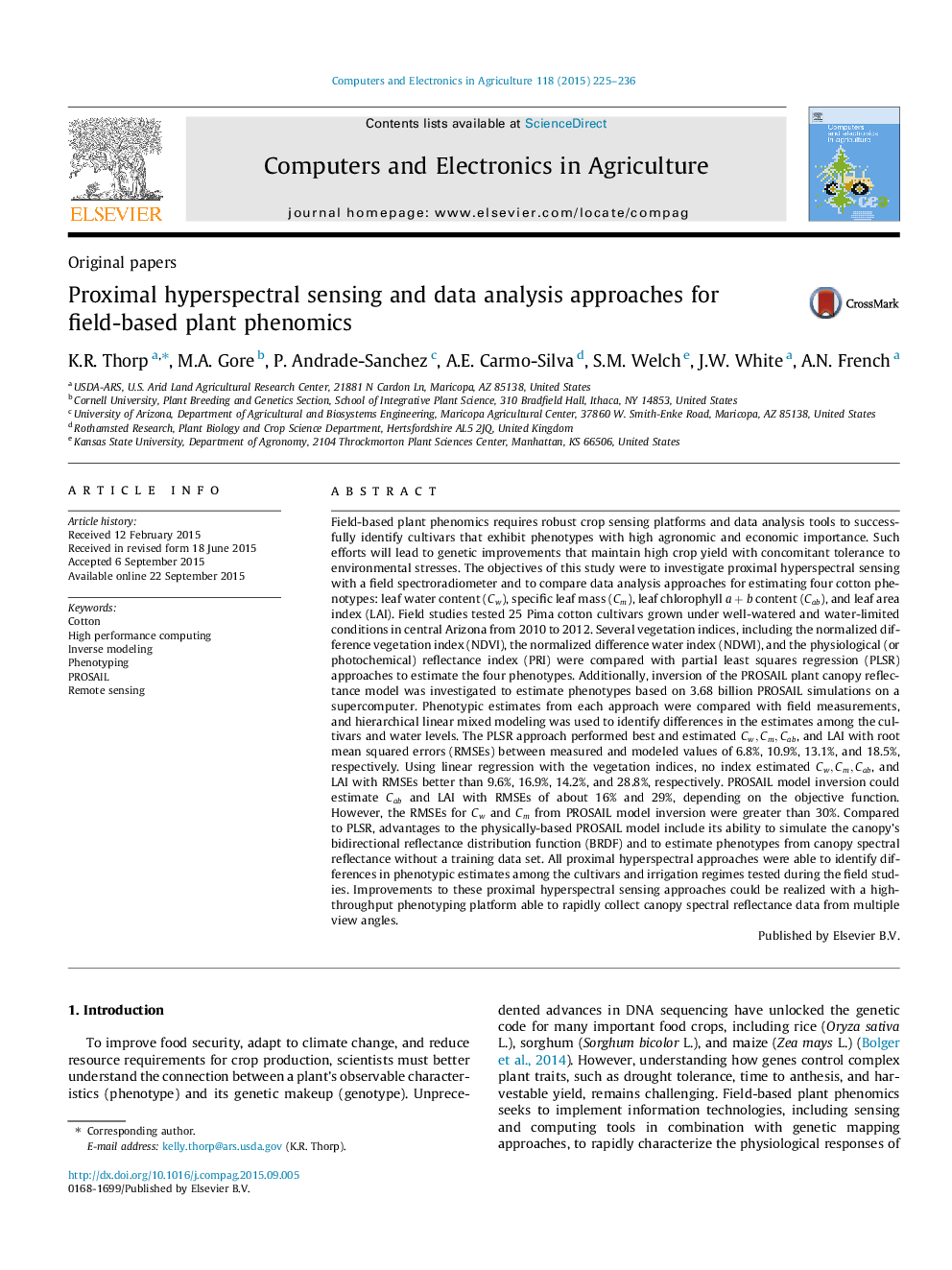| کد مقاله | کد نشریه | سال انتشار | مقاله انگلیسی | نسخه تمام متن |
|---|---|---|---|---|
| 84091 | 158860 | 2015 | 12 صفحه PDF | دانلود رایگان |
• Field-based proximal hyperspectral data was collected for cotton phenotyping.
• 3.68 billion PROSAIL runs on a supercomputer were used for model inversion.
• Partial least squares regression models best estimated four cotton phenotypes.
• High-throughput capability will improve hyperspectral methods for phenomics.
Field-based plant phenomics requires robust crop sensing platforms and data analysis tools to successfully identify cultivars that exhibit phenotypes with high agronomic and economic importance. Such efforts will lead to genetic improvements that maintain high crop yield with concomitant tolerance to environmental stresses. The objectives of this study were to investigate proximal hyperspectral sensing with a field spectroradiometer and to compare data analysis approaches for estimating four cotton phenotypes: leaf water content (CwCw), specific leaf mass (CmCm), leaf chlorophyll a+ba+b content (CabCab), and leaf area index (LAI). Field studies tested 25 Pima cotton cultivars grown under well-watered and water-limited conditions in central Arizona from 2010 to 2012. Several vegetation indices, including the normalized difference vegetation index (NDVI), the normalized difference water index (NDWI), and the physiological (or photochemical) reflectance index (PRI) were compared with partial least squares regression (PLSR) approaches to estimate the four phenotypes. Additionally, inversion of the PROSAIL plant canopy reflectance model was investigated to estimate phenotypes based on 3.68 billion PROSAIL simulations on a supercomputer. Phenotypic estimates from each approach were compared with field measurements, and hierarchical linear mixed modeling was used to identify differences in the estimates among the cultivars and water levels. The PLSR approach performed best and estimated Cw,Cm,CabCw,Cm,Cab, and LAI with root mean squared errors (RMSEs) between measured and modeled values of 6.8%, 10.9%, 13.1%, and 18.5%, respectively. Using linear regression with the vegetation indices, no index estimated Cw,Cm,CabCw,Cm,Cab, and LAI with RMSEs better than 9.6%, 16.9%, 14.2%, and 28.8%, respectively. PROSAIL model inversion could estimate CabCab and LAI with RMSEs of about 16% and 29%, depending on the objective function. However, the RMSEs for CwCw and CmCm from PROSAIL model inversion were greater than 30%. Compared to PLSR, advantages to the physically-based PROSAIL model include its ability to simulate the canopy’s bidirectional reflectance distribution function (BRDF) and to estimate phenotypes from canopy spectral reflectance without a training data set. All proximal hyperspectral approaches were able to identify differences in phenotypic estimates among the cultivars and irrigation regimes tested during the field studies. Improvements to these proximal hyperspectral sensing approaches could be realized with a high-throughput phenotyping platform able to rapidly collect canopy spectral reflectance data from multiple view angles.
Journal: Computers and Electronics in Agriculture - Volume 118, October 2015, Pages 225–236
